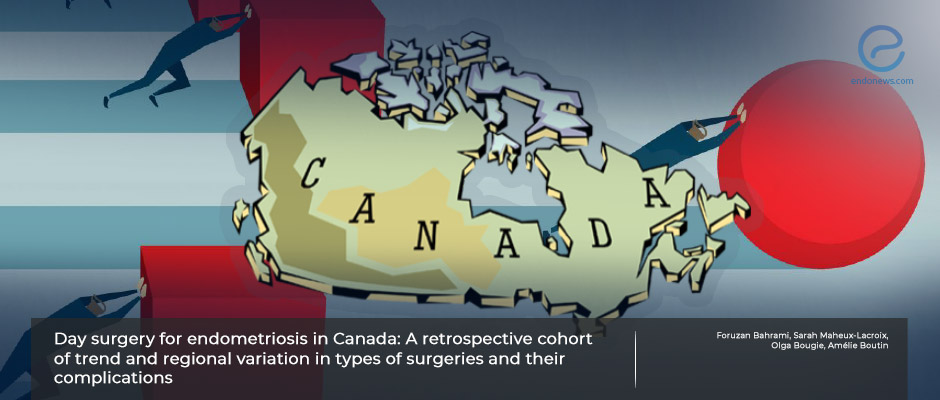Changes over time in day surgery for endometriosis in Canada
Jul 11, 2023
Over time, the rate of day surgery for endometriosis has remained constant, but the frequency of perioperative complications has decreased.
Key Points
Highlights:
- The developmental risk of perioperative complications after day surgery for endometriosis shows a regional variability.
Importance:
- The risk of perioperative complications including infectious, respiratory, embolic, anesthetic, urinary, and accidental damages after endometriosis surgery should be clearly explained.
What’s done here?
- This retrospective cohort study was conducted on women undergoing day surgery for endometriosis in 4 provinces of Canada.
- The aim is the evaluate the trend and regional variation in day surgeries for endometriosis, and the risk of perioperative complications through the years in Canada.
- All clinical and demographic characteristics were analyzed (age, site of endometriosis, length of surgery, length of hospitalization).
- Operations were classified as minor conservative (biopsy, minor adhesiolysis, etc), major conservative surgeries (unilateral/bilateral salpingo-oopherectomy, lesion excision, resections, etc), or hysterectomies.
- Perioperative complications were categorized as infectious, respiratory, embolic, anesthetic, urinary, accidental damages, and blood transfusion.
- Perioperative complication rates were calculated after adjustment of the site of endometriosis, age, type of surgical intervention, and comorbidities.
Key results:
- Almost 17 thousand patients who met the eligibility criteria were enrolled in this study.
- Hysterectomy [691 patients (4.1%)], major conservative surgery [(9631 patients (56.7%)], and minor conservative surgery [6660 patients (39.2%)] were performed.
- The age of conservative surgeries was earlier compared to hysterectomy.
- Perioperative complications were most frequently experienced during hysterectomy, major conservative and minor conservative surgeries, respectively.
- Although surgeries were more frequently performed by gynecologists, other specialties such as general surgeons, urologists, and gastroenterologists also performed the operations.
- The rate of day surgeries for endometriosis remained nearly stable (80–90 per 100 000 women) over the 5-year study period.
- Day surgery rates for endometriosis, especially minor conservative surgeries, and perioperative complications were significantly higher in provinces with greater proportions of rural populations.
- The overall rates of perioperative complications decreased significantly with time after adjustment of clinical characteristics.
Strengths and Limitations
- The population-based sampling and large sample size are the main strengths of this study.
- The inability to include surgical data from all provinces of Canada, the short time span of the study, and limited details about surgical techniques are the limitations.
Lay Summary
There are several medical and surgical treatment options for the management of endometriosis. Surgical approach is generally preferred in women with atypical endometrioma appearance on ultrasound, and who have persistent pain despite medical treatment. Surgery is often the first choice for endometriomas with rapid increase in size.
Bahrami et al., from Canada, published a study titled “Day surgery for endometriosis in Canada: A retrospective cohort of trend and regional variation in types of surgeries and their complications” in the journal named "The Australian and New Zealand Journal of Obstetrics and Gynaecology". These authors aimed to assess trends and regional variations in day surgeries for endometriosis and to report the risk of perioperative complications through the years in Canada.
While the age of conservative surgery was mostly between the ages of 25-39, hysterectomy was performed at more advanced ages. The rate of day surgeries for endometriosis remained nearly stable which is 80–90 cases per 100 000 women, over the 5-year study period. The rate of minor conservative surgery decreased over the years whereas the rate of hysterectomy increased. The overall rates of perioperative complications decreased significantly with time after adjustment of clinical characteristics. However, perioperative complications were most frequently experienced during hysterectomy, major conservative, and minor conservative surgeries. Day surgery rates for endometriosis, especially minor conservative surgeries, and perioperative complications were significantly higher in provinces with greater proportions of rural populations.
“Our study provides insight into how day surgeries and complication rates have evolved through the last few years. It also suggests additional research into regional differences and practice variations is needed to ensure all patients have access to high-quality care across the country.” the authors added.
Research Source: https://pubmed.ncbi.nlm.nih.gov/37264738/
hysterectomy complications day surgery endometriosis regional variations conservative surgery

